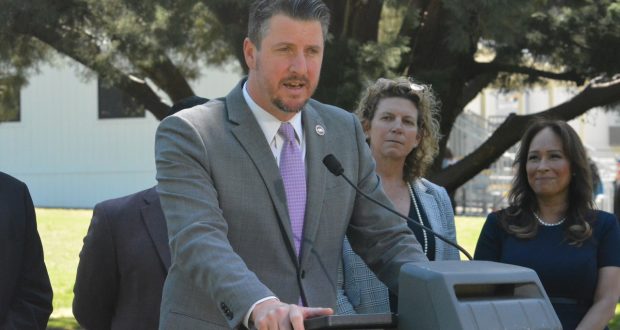By Antonio Ray Harvey | California Black Media
On May 16, the Senate Appropriations Committee voted 5-0 to advance legislation that would require social media platforms to report cyberbullying incidents and remove posts depicting youth violence online.
Senate Bill (SB) 1504, titled “Cyberbullying Reporting and Accountability,” “addresses the online safety for youth,” said the bill’s author Sen. Henry Stern (D-Calabasas).
“We must do everything in our power to protect our children from the dangers of social media,” Stern said. “By establishing a mandatory process for removing and blocking cyberbullying material and providing transparency to survivors and parents, we aim to create a safer online environment for all.”
Senators Brian Jones (R-San Diego) and Kelly Seyarto (R-Murrieta) abstained from voting. California Legislative Vice Chair Sen. Steven Bradford (D-Inglewood) was one of five Democrats who voted for the bill. It now moves to the Senate floor for a full vote.
SB 1504 is designed to make social media platforms such as Instagram, TikTok, Facebook, and others “respond compassionately and predictably” to reports of cyberbullying or they must explain why the content is “aligned with their platform’s policies,” Sen. Stern said at a May 14 news conference in front of the State Capitol.
Another child safety focused bill, SB 1444 — titled the “Parents Choose Protection Act of 2024” — died in committee on May 16 “due to fiscal implications,” Stern stated. This bill would have required companies to issue alerts to parents about potentially harmful content.
Two fathers, Samuel P. Chapman and Chris Didier, who lost their young sons to Snapchat drug dealers came to the Capitol to support the child safety bills.
“Social media has become a super-highway of illegal and nefarious activity that is bringing harm to our youth,” Didier said. “It is time for new legislation to bring needed and appropriate safeguards to protect our communities.”
According to Stern’s office, 56% of teens have reported being cyberbullied, and that youth are likely to struggle with depression and substance abuse due to online intimidation.
Black or Hispanic teens are more likely than their White counterparts to be targets of cyberbullying, according to the California Department of Justice (DOJ). ??Black teens are about twice as likely as Hispanic or White teens to express that their race or ethnicity made them a target of online mistreatment, according to a 2002 survey by the Pew Research Center.
Cyberbullying has been associated with suicide or the newly termed “cyberbullicide,” according to a February 2023 report by the Journal of the Academy Psychiatry and the Law (JAPL).
The phenomena of cyberbullying and teen suicide are becoming more common. Data provided by the Centers for Disease Control and Prevention through the JAPL report states that 14% of adolescents have been cyberbullied and 13.6% percent of teens have made suicide attempts.
If passed, SB 1504 would “authorize any person,” including, “a parent or legal guardian of a minor,” who bring forth a report of cyberbullying to the “social media platform, a city attorney, a district attorney, or a county counsel to bring an action to enforce the act.”
Sen. Rosilicie Ochoa-Bogh (R-Yucaipa), the first Republican Latina to serve in the Senate, is the co-author of SB 1504.
“I’m happy to co-author SB 1504 to help safeguard our youth and empower families to pursue legal action against platforms that fail to remove cyberbullying content, providing much-needed recourse in the face of online harassment,” ??Ochoa-Bogh said at the May 14 news conference.
Stern said the legislation will help combat the growing popularity of “fight pages” created by adolescents and uploaded to social media platforms.
Those fight pages feature videos of elementary, middle school and high school youth physically fighting in bathrooms, classrooms, lunchrooms, playgrounds and other places. In many cases, campus violence happens in unsupervised spaces and in the presence of adults.
The popularity of the videos caught the attention of Stern. He shared the story about a teen from a local high school in his area who was paralyzed after three of his peers approached him “out of the blue” while he was walking down a street, Stern said. The aggressors were members of a “knockout club.”
“It was three kids. One with a camera and one got their phone on,” Stern said. “They cold clocked him. Not just knocked him out but paralyzed him and put him in a life of trauma that he can never recover from.”
Stern said the fight pages are “proliferating everywhere.” Earlier this year, a report stated that 14 schools within the Fresno Unified School District were identified as having social media pages promoting school fights.
The social media accounts were not administered by the schools, but the fight pages did display schools’ logos, and mascots and urged other students to contribute videos of fights for viewership.
“Incidentally, there are also pages around sexual content of students rating people using artificial intelligence to generate nude images. (SB 1504) covers all bad behaviors,” Stern said. “That kind of bullying, we nip it in the bud before it starts. When those fight pages emerge, anyone observing it can report it to that platform. They would have to respond to it within a matter of days and actually in a matter of hours.”
 Westside Story Newspaper – Online The News of The Empire – Sharing the Quest for Excellence
Westside Story Newspaper – Online The News of The Empire – Sharing the Quest for Excellence





